Abstract
A field study was conducted at the Certified Organic Farm in Poland over the period 2014–2016. This study evaluated weed infestation and seed yield of the lentil varieties ‘Tina’ and ‘Anita’, as well as of a mixture of these two varieties, sole cropped and row intercropped with naked oats as a supporting crop. Additionally, lentil was sown at a different row spacing of 20 and 25 cm. The lentil variety ‘Anita’ produced 25.3% higher yields than var. ‘Tina’. Weight of 1000 seed, number of pods per plant, and first pod height did not differ significantly in the treatments with the lentil varieties. The lentil seed yield obtained in the treatments with a supporting crop was lower by 9.4% compared with the sole cropped plots. In turn, the 1000 seed weight was 3.9% higher in the treatment where a supporting crop was used. The presence of oats as a supporting crop in lentil crop allowed crop competitiveness against weeds to be increased significantly, thus reducing their total number and dry weight by 5.3% and 30.5%, respectively. Sowing lentil at different row spacings did not have a significant effect on seed yield and weed infestation in crop. The greatest diversity of weed species was found in the treatments where the mixture of the lentil varieties was sown and in the treatment with the smaller row spacing. Intercropping of lentil with oats resulted in reduced occurrence of monocotyledonous weeds such as Echinochloa crus-galli and Elymus repens. The presence of oat as a supporting crop can effectively reduce the pressure from weeds without significantly reducing lentil cultivar yield in organic farming.
1. Introduction
The lentil (Lens culinaris Medic.) is one of the oldest cultivated legume crops. Due to its valuable chemical composition and health-promoting properties, it is a desirable element of an everyday diet. Lentil seeds contain from 24% to 32% of valuable protein and are also a rich source of phytoestrogens, folic acid, group B vitamins, and micronutrients [1,2,3]. Lentil can have a potential role in crop rotation, in particular in organic farms, allowing the biological equilibrium of agroecosystems and soil fertility to be maintained [4]. The special ability of leguminous plants to live in symbiosis with rhizobia that fix free atmospheric nitrogen also needs to be stressed [5]. In spite of many beneficial characteristics of lentil, the acreage of this crop in organic farms is quite low. The reason for this is likely due to its high susceptibility to lodging and low competitiveness against weeds [6,7].
One of the methods for protecting lentil against lodging can be its row intercropping with other crop species [8]. The presence of a low-growing inter-row crop that does not compete for light and occupies additional space can increase crop competitiveness and effectively reduce the pressure from fungal pathogens and weeds [8,9,10,11,12]. In mixed cropping systems, the increased proportion of companion crops (usually cereals) can suppress weeds without significantly reducing lentil yield [13,14]. The oat, which not only competes well with weeds but also has phytosanitary properties, is a species that is perfectly suitable for row intercropping with lentil [15].
Sowing mixtures of varieties can be an important element of organic cropping of lentil. Compared to sole cropping, this cultivation method can contribute to a better use of space in crop, reduce the spread of fungal pathogens, and increase yield stability when adverse conditions occur during the growing season [16].
In organic farming, in which herbicide application is prohibited, there is a constant need to seek new effective solutions for controlling the occurrence of weeds [17]. It seems that row intercropping, sowing different varieties that are adapted to soil and climatic conditions, and different crop densities can be an effective tool for reducing the occurrence of weeds, and thus for increasing yield effectiveness and seed quality of lentil and other legumes grown under organic farming conditions [5,18,19,20]. This study hypothesized that row intercropping of lentil with a supporting crop would effectively reduce crop lodging and, in consequence, improve the crop competitive ability against weeds. The supporting component would also provide benefits in the form of an additional oat grain yield.
The aim of this study was to evaluate yield and weed infestation in lentil crop grown in pure stand and using a variety mixture (50% + 50%) as well as row intercropped with naked oats as a supporting crop at a row spacing of 20 and 25 cm, under an organic farming system.
2. Materials and Methods
The field experiment was carried out in the years 2014–2016, at the Model Organic Farm in Chwałowice (Municipality of Iłża, Radom County, Masovian Voivodeship) belonging to the Agricultural Advisory Center in Brwinów, Radom Branch, Poland (51°18′N, 21°30′E). The experiment was set up on brown soil (CAMBISOLS according to the World Reference Base for Soil Resources 2014) [21], with an organic carbon content of 14.11 g kg−1 and a pH of 6.15 in 1 M KCl. The soil was characterized by the following nutrient content: P—73.9 mg kg−1; K—1430 mg kg−1; Mg—1765 mg kg−1. The experiment was set up as a split-block design with three replicates. The area of a single plot was 8 m2. The scheme of the experiment included three factors: (i) lentil varieties ‘Tina’ and ‘Anita’, mixture of varieties: ‘Tina’ (50%) and ‘Anita’ (50%); (ii) row spacing: 20 cm, 25 cm; (iii) lentil cropping method: sole cropping (without a supporting crop), row intercropping with naked oats (Avena nuda L. var. ‘Polar’).
The previous crop of lentil was a legume (Vicia sativa L.)/cereal mixture (Hordeum vulgare L.). Soil tillage, preparing the field for lentil, started with skimming and harrowing after harvesting the previous crop. Ploughing was done to an average depth before the winter. In the spring, harrowing was performed, and before sowing, 15 t ha−1 of manure-based compost was applied and ploughed in. Lentil seeds at a rate of 90 kg ha−1 and oat seeds at a rate of 50 kg ha−1 were sown in the second 10 days of April. Naked oats were sown separately in the interrows of the lentil crop (Figure 1). Sowing was carried out using self-propelled plot drill Øyjord Wintersteiger (Austria).
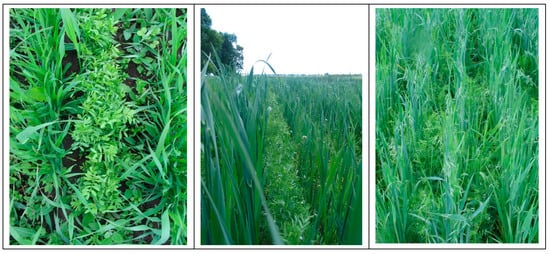
Figure 1.
Canopy of lentil cultivated with naked oat as a supporting crop.
Evaluation of weed infestation in lentil crop was performed during the flowering period of lentil using the quantitative-gravimetric method. Analysis consisted in determining the number, species composition, and dry weight of weeds on sample areas determined in four randomly selected places in each plot delineated by a 1 × 0.25 m quadrat frame.
Before harvest, plants of lentil and oat were cut by hand from 2 m2 sampling areas in each plot to calculate the plant density. In addition, average lower pod setting height in lentil plants and number of pods from single lentil plant were determined. Collected samples were threshed using laboratory thresher Wintersteiger LD 180 and the seed yield obtained was calculated on a per-hectare basis. The weight of 1000 seeds was determined on the basis of seed samples collected from each plot. The remaining plants were harvested using a Winterstiger combine.
The dates presented are the mean values from the years 2014–2016. The results were statistically analyzed with the use of the analysis of variance using Statistica PL 13.3 (TIBCO Software Inc., Tulsa, OK, USA). Tukey’s multiple comparison test was used to compare differences between the means for main factors (cultivars: C, row spacing: RS, lentil cropping method: LCM), whereas confidence intervals for the means of LSD (p = 0.05) were used to compare the means from the subclasses (interaction C × RS, C × LCM, RS × LCM).
Weather Conditions
Throughout the experiment period, weather conditions varied substantially between the years. The highest amount of rainfall was recorded in 2014, in particular in May and July (Figure 2a). From April to August, the total rainfall was higher than the long-term average by 46%. The average air temperature in this vegetative season exceeded the long-term average by 1.6 °C (Figure 2b).
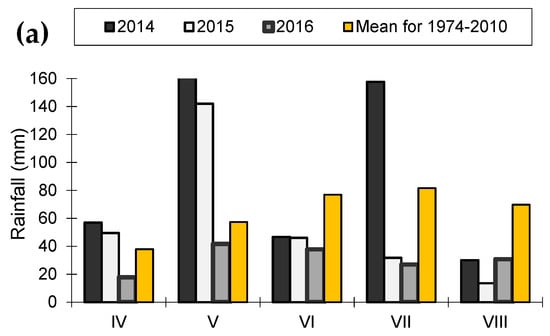

Figure 2.
Rainfall (a) and temperature (b) in the vegetation seasons of the years 2014–2016 according to the Meteorological Station at Model Organic Farm in Chwałowice.
In 2015, the air temperature was at a similar level as in the first year of the study, but the amount of rainfall was on average lower by 40%. During June, July, and August the total rainfall was only 60%, 39%, and 19% of the long-term average, respectively.
The year 2016, in turn, was the warmest and at the same time driest because in this year the air temperature was higher by about 6 °C compared with 2014 and 2015, whereas the total rainfall was lower by 67% and 45%, respectively. In every month of this year, total rainfall was lower compared with long-term average from 27% (May) to 67% (July).
3. Results and Discussion
The results of the study showed no significant interaction between the experimental factors with respect to number of monocotyledonous weeds, weight of 1000 seeds, average lower pod setting height in lentil plants, number of pods from single plant, and number of lentil plants per 1 m2 (Table 1), and therefore this paper presents the relationships of the traits studied with the main effects.

Table 1.
Effect of cultivar, row spacing, lentil cropping method, and interaction of experimental factors on examined features.
The presence of weeds in lentil crop results in a substantial loss in seed yield [22,23]. Moreover, lentil is a species that poorly competes with weeds [24]. The weed species composition in lentil crop grown in pure stand and in mixed variety stand was similar (Table 2). Independent on row spacing and lentil cropping method, the highest number of species (48) was found in the treatment where the mixture of the lentil varieties was sown, whereas their lowest number was found in the plots with var. ‘Tina’ (44). In all experimental treatments, the dominant weed species were Echinochloa crus-galli, Galinsoga parviflora, Sonchus arvensis, and Chenopodium album. Furthermore, Elymus repens was found to occur in quite large numbers in the var. ‘Tina’ crop. Nevertheless, a large majority of taxa occurred sporadically and their impact on weed infestation was small. Compared to the results obtained in this experiment, in a study by Lejman et al. [25], a mixture of barley with field pea was characterized by low variation in weed species composition because only 11 taxa were identified in the crop. In turn, Staniak et al. [26] found that weed species richness was independent of the mixture composition, with the number of weed species ranging between 25 and 32.

Table 2.
Species composition and number of weeds (plants m−2) in the crops of lentil depending on lentil cultivars (mean for 2014–2016; independent on row spacing and lentil cropping method).
Different row spacing had a small effect on the weed species composition in lentil crop. Regardless of the cultivar and lentil cropping method, over the 3 year study period, 51 weed species were found to occur in the plots with a row spacing of 20 cm, whereas 5 species fewer were recorded in the treatment with a row spacing of 25 cm (Table 3). The wider row spacing contributed to significant reduction in the numbers of the dominant species, that is, G. parviflora (on average by 36% compared to a spacing of 20 cm), but the density of Thlaspi arvense significantly increased.

Table 3.
Species composition and number of weeds (plants m−2) in the crops of lentil depending on row spacing (mean for 2014–2016; independent on cultivar and lentil cropping method).
Compared to the sole cropping of lentil, row intercropping of lentil with oats as a supporting crop caused a decrease in the number of dicotyledonous weed species (from 43 to 39), but the number of monocotyledonous taxa increased (from 6 to 9) (Table 4). On both experimental treatments, independent of cultivar and row spacing, S. arvensis, G. parviflora, and Ch. album were weeds that occurred in greatest number, whereas among monocotyledonous weeds these were E. crus-galli and E. repens. Likewise, in the study by Lejman et al. [25] E. crus-galli was the most numerous from the group of monocotyledonous species in a mixture of barley with pea. Bojarszczuk et al. [27], and Staniak et al. [26] found that mostly dicotyledonous weeds, such as Ch. album, Stellaria media, Capsella bursa-pastoris, and G. parviflora, were dominant in cereal–legume mixtures. In this study, the presence of oats as a supporting crop in lentil cultivation resulted in a significant reduction in the numbers of T. arvense and E. repens (respectively by 65% and 39%), but at the same time the density of G. parviflora significantly increased by 56%.

Table 4.
Species composition and number of weeds (plants m−2) in the crops of lentil depending on lentil cropping method (mean for 2014–2016; independent on cultivar and row spacing).
In the var. ‘Anita’ crop, independent of row spacing and lentil cropping method, a significantly lower number of dicotyledonous, monocotyledonous, and total weeds was determined compared with the plots with var. ‘Tina’ (Figure 3a–c). At the same time, the total number of weeds in the var. ‘Tina’ crop was significantly higher than in the treatment with the varietal mixture. An opposite relationship was found in the case of weed dry weight (Figure 3d).
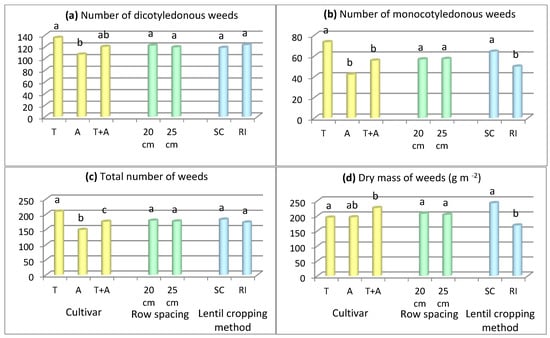
Figure 3.
The number of dicotyledonous weeds (a), monocotyledonous weeds (b), total number of weeds (c), and dry mass of weeds (d) in lentil crop as influenced by cultivar, row spacing, and lentil cropping method (mean for 2014–2016). Different letters indicate significant difference at p ≤ 0.05. T: var. ‘Tina’, A: var. ‘Anita’, SC: sole cropping of lentil without a supporting plant, RI: row intercropping of lentil with naked oat.
The presence of oats as an intercropped crop in lentil crop, regardless of lentil cultivar and row spacing, did not have a significant impact on number of dicotyledonous weeds and total weeds. Compared to lentil grown in pure stand, on the other hand, a significant decrease was found in the number of monocotyledonous weeds (by 22.4%) and weed dry weight (by 30.5%).
Statistical analysis confirmed the significant interaction between cultivars and lentil cropping method. Var. ‘Anita’, both cropped with and without oats, was the most competitive against dicotyledonous weeds (Figure 4). However, the lowest air dry mass of weeds was found in the var. ‘Tina’ intercropped with oats (Figure 5). The presence of oats as a supporting crop significantly reduced the air dry mass of weeds in the var. ‘Tina’ and mixture of ‘Tina’ and ‘Anita’ crops. This study demonstrated that row intercropping of lentil with naked oats significantly decreased the total number of weeds in the treatment with the row spacing of 25 cm but had no significant effect in the narrower row spacing (20 cm) (Figure 6).
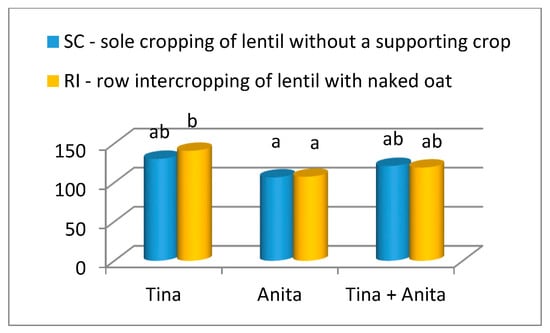
Figure 4.
The interaction effect of cultivar and lentil cropping method on the number of dicotyledonous weeds in lentil crop (plant m−2) (mean for 2014–2016; independent on row spacing). Different letters indicate significant difference at p ≤ 0.05. SC: sole cropping of lentil without a supporting plant, RI – row intercropping of lentil with naked oat.
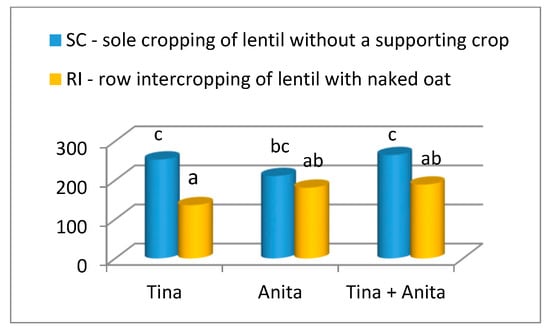
Figure 5.
The interaction effect of cultivar and lentil cropping method on the air dry weight of weeds in lentil crop (g m−2) (mean for 2014–2016; independent on row spacing). Different letters indicate significant difference at p ≤ 0.05. SC: sole cropping of lentil without a supporting plant, RI: row intercropping of lentil with naked oat.
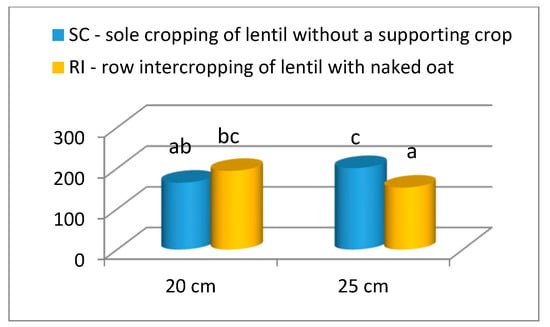
Figure 6.
The interaction effect of row spacing and lentil cropping method on the total number of weeds in lentil crop (plant m−2) (mean for 2014–2016; independent on cultivar). Different letters indicate significant difference at p ≤ 0.05. SC: sole cropping of lentil without a supporting plant, RI: row intercropping of lentil with naked oat.
As far as weed infestation reduction is concerned, mixed crops, in comparison to monovarietal crops, have a better adaptive ability as well as making better use of space and habitat resources and, in effect, reducing the pool of these resources for weeds [19]. In agricultural practice, legume–cereal mixtures or cereal mixtures are grown most frequently. Due to the morphological differentiation of individual components, higher weed control ability is attributed to mixtures that include legumes [28,29]. However, Boyd and Brennan [30] drew attention to high weed infestation of legume–cereal mixtures, which are quite frequently grown in organic farms.
The statistical analysis did not confirm the lentil varieties to have a significant effect on traits such as 1000 seed weight, first pod height, number of pods per plant, and plant density (Table 5). Lopez-Bellido et al. [9] found that number of pods per plant is inversely correlated with number of plants per unit area. This is confirmed by the present study, which showed that plants sown in narrower rows produced significantly more pods, but the lentil density was found to be much higher in the treatment with a row spacing of 25 cm (Table 6). Many authors are of the opinion that the factor that determines the yield of Fabaceae crops is ensuring optimal crop architecture [31,32,33]. An appropriate density of plants per unit area determines their proper growth and development and is a guarantee in obtaining a high seed yield [34,35].

Table 5.
Some morphological features of lentil plants depending on lentil cultivar (mean for 2014–2016; independent on row spacing and lentil cropping method).

Table 6.
Some morphological features of lentil plants depending on row spacing (mean for 2014–2016; independent on cultivar and lentil cropping method).
In this study, row intercropping of lentil with oats as a supporting crop beneficially affected thousand seed weight of lentil (Table 7). Compared to sole cropping, a significant decrease in plant density was however found (on average by 13.2%). As a result, the seed yield of lentil grown with oats was significantly lower (on average by 9.4%) than in the treatment without a supporting crop (Figure 7). Ciftci and Ülker [36] revealed a similar relationship when in their research lentil was intercropped with spring cereals. This could have resulted from the competitive effects of oats on lentil plants.

Table 7.
Some morphological features of lentil plants depending on lentil cropping method (mean for 2014–2016; independent on cultivar and row spacing).
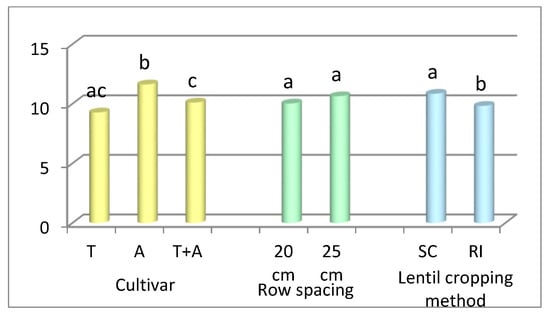
Figure 7.
The seed yield of lentil as influenced by cultivar, row spacing, and lentil cropping method (mean for 2014–2016). Different letters indicate significant difference at p ≤ 0.05. T: var. ‘Tina’, A: var. ‘Anita’, SC: sole cropping of lentil without a supporting plant, RI: row intercropping of lentil with naked oat.
Significant differences in seed yield of lentil cultivars were demonstrated (Figure 7). The variety ‘Anita’ produced the highest yields (11.63 dt ha−1), whereas var. ‘Tina’ and the variety mixture produced significantly lower seed yields, by 20.2% and 13.1%, respectively. In the opinion of Vlachostergios and Roupakias [5] there are large possibilities to increase seed yield of lentil grown under organic farming conditions through appropriate variety selection.
In the present study, the lentil seed yield in the treatments with different row spacings did not differ significantly, though in the case of a row spacing of 25 cm it was slightly higher (by 6.1%) than in the plots where lentil was sown at a spacing of 20 cm. In a study by Ouji et al. [35], lentil sown at a row spacing of 34 cm produced a 38% higher yield compared to a spacing of 17 cm. Bicer [31] believes that increased lentil crop density results in greater competition between plants and leads to a weakening of individual plants.
The effect of row spacing on lentil yield was dependent on the variety. A significant increase in seed yield as affected by the wider row spacing was only found in the treatment where the variety mixture was sown (on average by 25.7%), whereas the individual varieties gave similar yields as in the treatment with a spacing of 20 cm (Figure 8).
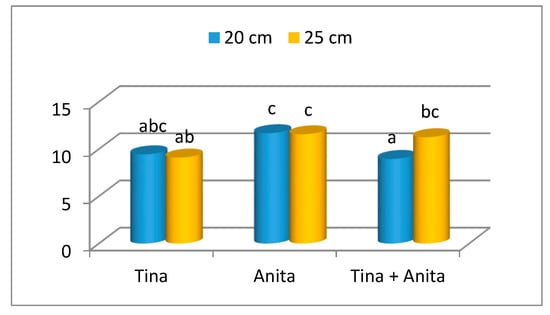
Figure 8.
The interaction effect of cultivar and raw spacing on seed yield of lentil crop (dt ha−1) (mean for 2014–2016; independent on lentil cropping method). Different letters indicate significant difference at p ≤ 0.05.
Statistical analysis showed that in the case of wider rows (25 cm) the presence of oats as a supporting crop caused significant decrease in seed yield of lentil (by 28.5% compared to sole cropping) (Figure 9). In the treatment with narrower row spacing (20 cm), row intercropping of lentil with oats positively influenced the lentil seed yield, but the determined differences were not confirmed statistically.
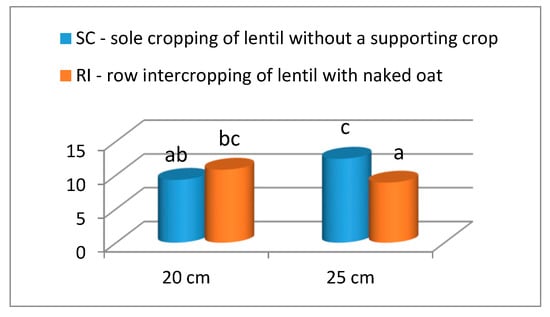
Figure 9.
The interaction effect of row spacing and lentil cropping method on seed yield of lentil crop (dt ha−1) (mean for 2014–2016; independent on cultivar). Different letters indicate significant difference at p ≤ 0.05.
4. Conclusions
Selection of lentil varieties to be grown under organic farming conditions has a significant effect on seed yield. It is largely determined by their competitive ability towards weeds. The lentil variety ‘Anita’ produced higher yields compared to ‘Tina’, but at the same time the variety mixture gave higher yields than var. ‘Tina’ over the 3 year study period.
The presence of naked oats as a supporting crop in lentil crop allowed crop competitiveness against weed species to be increased, significantly reducing the dry weed weight. Nevertheless, intercropping of lentil with oats caused a significant decrease in lentil seed yield, on average by 9.4%, compared to sole cropping. This was probably associated with the competitive interactions of plants, as also evidenced by the lower density of lentil grown in the presence of oats.
Sowing lentil at different row spacings did not have a significant impact on the number and weight of weeds in lentil crop, as well as on seed yield. Nonetheless, the plant density was found to be higher in the treatments where lentil was sown in wider rows, with a simultaneous decrease in the number of pods per plant. However, for practical reasons, it is better to sow lentil, together with the supporting crop, in wider rows.
In lentil crop grown under organic farming conditions, Sonchus arvensis, Stellaria media, Chenopodium album, Thlaspi arvense, Matricaria maritima subsp. inodora, Galinsoga parviflora, Plantago major, Echinochloa crus-galli, and Elymus repens were species that occurred in greatest numbers. The greatest diversity of weed species was determined in the treatments where the mixture of the lentil varieties was sown and in the treatment with the smaller row spacing. Intercropping of lentil with oats resulted in reduced occurrence of Echinochloa crus-galli and Elymus repens.
Author Contributions
P.K. conceptualized the research; P.K. and S.A. designed the research; P.K., S.A., E.K.-P., and K.R. performed the experiments; P.K., S.A., M.S., and H.R. analyzed the data; P.K. and S.A. wrote the paper. All authors have read and agreed to the published version of the manuscript.
Funding
This research was funded by the Ministry of Agriculture and Rural Development, Ministry of Science and Higher Education, Poland.
Acknowledgments
This research was supported by the Ministry of Agriculture and Rural Development in Poland.
Conflicts of Interest
The authors declare no conflict of interest. The funders had no role in the design of the study; in the collection, analyses or interpretation of data; in the writing of the manuscript, or in the decision to publish the results.
References
- Vlachostergios, D.N.; Lithourgidis, A.S.; Roupakias, D.G. Adaptability to organic farming of lentil (Lens culinaris Medik.) varieties developed from conventional breeding programmes. J. Agric. Sci. 2011, 149, 85–93. [Google Scholar] [CrossRef]
- Alghamdi, S.; Khan, A.M.; Ammar, M.H.; El-Harty, E.H.; Migdadi, H.M.; El-Khalik, S.M.A.; Al-Shameri, A.M.; Javed, M.M.; Al-Faifi, S.A. Phenological, nutritional and molecular diversity assessment among 35 introduced lentil (Lens culinaris Medik.) genotypes grown in Saudi Arabia. Int. J. Mol. Sci. 2014, 15, 277–295. [Google Scholar] [CrossRef] [PubMed]
- Kahraman, A. Nutritional components and amino acids in lentil varieties. Selcuk. J. Agric. Food Sci. 2016, 30, 34–38. [Google Scholar]
- Sellami, M.H.; Pulvento, C.; Aria, M.; Stellacci, A.M.; Lavini, A. A systematic review of field trials to synthesize existing knowledge and agronomic practices on protein crops in Europe. Agronomy 2019, 9, 292. [Google Scholar] [CrossRef]
- Vlachostergios, D.N.; Roupakias, D.G. Response to conventional and organic environment of thirty-six lentil (Lens culinaris Medik.) varieties. Euphytica 2008, 163, 449–457. [Google Scholar] [CrossRef]
- Carr, M.P.; Gardner, C.J.; Schatz, G.B.; Zwinger, W.S.; Guldan, J.S. Grain yield and weed biomass of a weat-lentil intercrop. Agron. J. 1995, 87, 574–579. [Google Scholar] [CrossRef]
- Chaudhary, S.U.; Iqbal, J.; Hussain, M.; Waijd, A. Economical weed control in lentils crop. J. Anim. Plant Sci. 2011, 21, 734–737. [Google Scholar]
- Lithourgidis, A.S.; Dordas, C.A.; Damalas, C.A.; Vlachostergios, D.N. Annual intercrops: An alternative pathway for sustainable agriculture. Aust. J. Crop Sci. 2011, 5, 396–410. [Google Scholar]
- Lopez-Bellido, F.J.; Lopez-Bellido, L.; Lopez-Bellido, R.J. Competition, growth and yield of faba bean (Vicia faba L.). Eur. J. Agron. 2005, 23, 359–378. [Google Scholar] [CrossRef]
- Schmidtke, K.; Neumann, A.; Hof, C.; Rauber, R. Soil and atmospheric nitrogen uptake by lentil (Lens culinaris Medik.) and barley (Hordeum vulgare ssp. nudum L.) as monocrops and intercrops. Field Crop. Res. 2004, 87, 245–256. [Google Scholar] [CrossRef]
- Hauggaard-Nielsen, H.; Gooding, M.; Ambus, P.; Corre-Hellou, G.; Crozat, Y.; Dahlmann, C.; Dibet, A.; Von Fragstein, P.; Pristeri, A.; Monti, M.; et al. Pea–barley intercropping for efficient symbiotic N2-fixation, soil N acquisition and use of other nutrients in European organic cropping systems. Field Crop. Res. 2009, 113, 64–71. [Google Scholar] [CrossRef]
- Wang., L.; Gruber, S.; Claupein, W. Optimizing lentil-based mixed cropping with different companion crops and plant densities in terms of crop yield and weed control. Org. Agric. 2015, 2, 79–87. [Google Scholar] [CrossRef]
- Gruber, S.; Zikeli, S.; Wahl, E.; Claupein, W. Perspectives and limitations of weed control in organic lentils (Lens culinaris). J. Kulturpflanzen 2012, 64, 365–377. [Google Scholar]
- Wang, L.; Gruber, S.; Claupein, W. Effects of woodchip mulch and barley intercropping on weeds in lentil crops. Weed Res. 2012, 52, 161–168. [Google Scholar] [CrossRef]
- Hiltbrunner, J. Organic lentil production—the development of an interesting niche in Switzerland. In Proceedings of the 14th ESA Congress, Edinburgh, Scotland, 5–9th September 2016; pp. 13–14. [Google Scholar]
- Akter, N.; Alim, M.A.; Mahbubul, I.M.; Naher, Z.; Rahman, M.; Iqbal Hossain, A.S.M. Evaluation of mixed and intercropping of lentil and wheat. J. Agron. 2004, 3, 48–51. [Google Scholar] [CrossRef]
- Bond, W.; Grundy, A.C. Non-chemical weed management in organic farming systems. Weed Res. 2001, 41, 383–405. [Google Scholar] [CrossRef]
- Banik, P.; Midya, A.; Sarkar, B.K.; Ghose, S.S. Wheat and chickpea intercropping systems in an additive series experimnt: Advantages and weed smothering. Eur. J. Agron. 2006, 24, 325–332. [Google Scholar] [CrossRef]
- Avola, G.; Tuttobene, R.; Gresta, F.; Abbate, V. Weed control strategies for grain legumes. Agron. Sustain. Dev. 2008, 28, 389–395. [Google Scholar] [CrossRef]
- Kraska, P.; Andruszczak, S.; Staniak, M.; Kwiecińska-Poppe, E.; Różyło, K.; Rusecki, H. Evaluation of chemical composition of lentil seeds in sole crop and row intercropped with oats in an organic farm. Appl. Ecol. Environ. Res. 2018, 16, 1855–1867. [Google Scholar] [CrossRef]
- World Reference Base for Soil Resources 2014. International Soil Classification System for Naming Soil and Creating Legends for Soil Maps; World Soil Resources Reports, 106; Food and Agriculture Organization of the United Nations: Rome, Italy, 2015; pp. 144–181. [Google Scholar]
- Malik, B.P.S.; Singh, R.C. The influence of seeding rate and weed control in small seeded lentils (Lens culinaris). Weed Sci. 1996, 45, 296–300. [Google Scholar]
- Fedoruk, L.K.; Johnson, E.N.; Shirtliffe, S.J. The critical period of weed control for lentil in Western Canada. Weed Sci. 2011, 59, 517–526. [Google Scholar] [CrossRef]
- Singh, K.M.; Kumar, M.; Choudhary, S.K. Effect of weed management practices on growth and yield of lentil (Lens esculenta Moench). Int. J. Curr. Microbiol. App. Sci. 2018, 7, 3290–3295. [Google Scholar]
- Lejman, A.; Sobkowicz, P.; Ogórek, R. Species diversity and number of weeds in barely-pea mixture as affected by weed control method. Fragm. Agron. 2017, 34, 105–116. [Google Scholar]
- Staniak, M.; Bojarszczuk, J.; Księżak, J. Weed infestations of mixtures of blue lupine with spring cereals in organic farming system. J. Res. Appl. Agric. Eng. 2013, 58, 155–160. [Google Scholar]
- Bojarszczuk, J.; Staniak, M.; Księżak, J. Weed infestation of mixture of pea with spring wheat cultivated in organic system. J. Res. Appl. Agric. Eng. 2013, 58, 33–40. [Google Scholar]
- Poggio, L.S. Structure of weed communities occurring in monoculture and intercropping of field pea and barley. Agric. Ecosyst. Environ. 2005, 109, 48–58. [Google Scholar] [CrossRef]
- Hauggaard-Nielsen, H.; Ambus, P.; Jensen, E.S. Interspecific competition, N use and interference with weeds in pea+barley intercropping. Field Crop. Res. 2001, 70, 101–109. [Google Scholar] [CrossRef]
- Boyd, N.S.; Brennan, E.B. Weed management in legume-cereal cover crop with the rotary hoe. Weed Technol. 2006, 20, 733–738. [Google Scholar] [CrossRef]
- Bicer, B.T. Some agronomic studies in chickpea (Cicer arietinum L.) and lentil (Lens culinaris Medik). Turk. J. Agric. Nat. Sci. 2014, 1, 42–51. [Google Scholar]
- Seyyed, G.M.; Mohamad, J.S.; Mohamad, R.D. Effect of sowing date and plant density on yield and yield components of lentil (Lens culinaris cv. Sistan). Annu. Res. Rev. Biol. 2014, 4, 296–305. [Google Scholar]
- Masa, M.; Tana, T.; Ahmed, A. Effect of plant spacing on yield and yield related traits of common bean (Phaseolus vulgaris L.) Varieties at Areka, Southern Ethiopia. J. Plant Biol. Soil Health 2017, 4, 1–13. [Google Scholar]
- Saleem, A.; Zahid, M.A.; Javed, H.I.; Ansar, M.; Ali, A.; Saleem, R.; Saleem, N. Effect of seeding rate on lentil (Lens culinaris Medik) seed yield under rainfed conditions. Pakistan, J. Agric. Res. 2012, 25, 181–185. [Google Scholar]
- Ouji, A.; El-Bok, S.; Omri Ben Youssef, N.; Rouaissi, M.; Mouelhi, M.; Ben Younes, M.; Kharrat, M. Impact of row spacing and seeding rate on yield components of lentil (Lens culinaris L.). J. New Sci. Agric. Biotech. 2016, 25, 1138–1144. [Google Scholar]
- Ciftci, V.; Ülker, M. Effect of mixed cropping lentil with wheat and barley at different seeding ratios. J. Agron. 2005, 4, 1–4. [Google Scholar] [CrossRef][Green Version]
© 2019 by the authors. Licensee MDPI, Basel, Switzerland. This article is an open access article distributed under the terms and conditions of the Creative Commons Attribution (CC BY) license (http://creativecommons.org/licenses/by/4.0/).